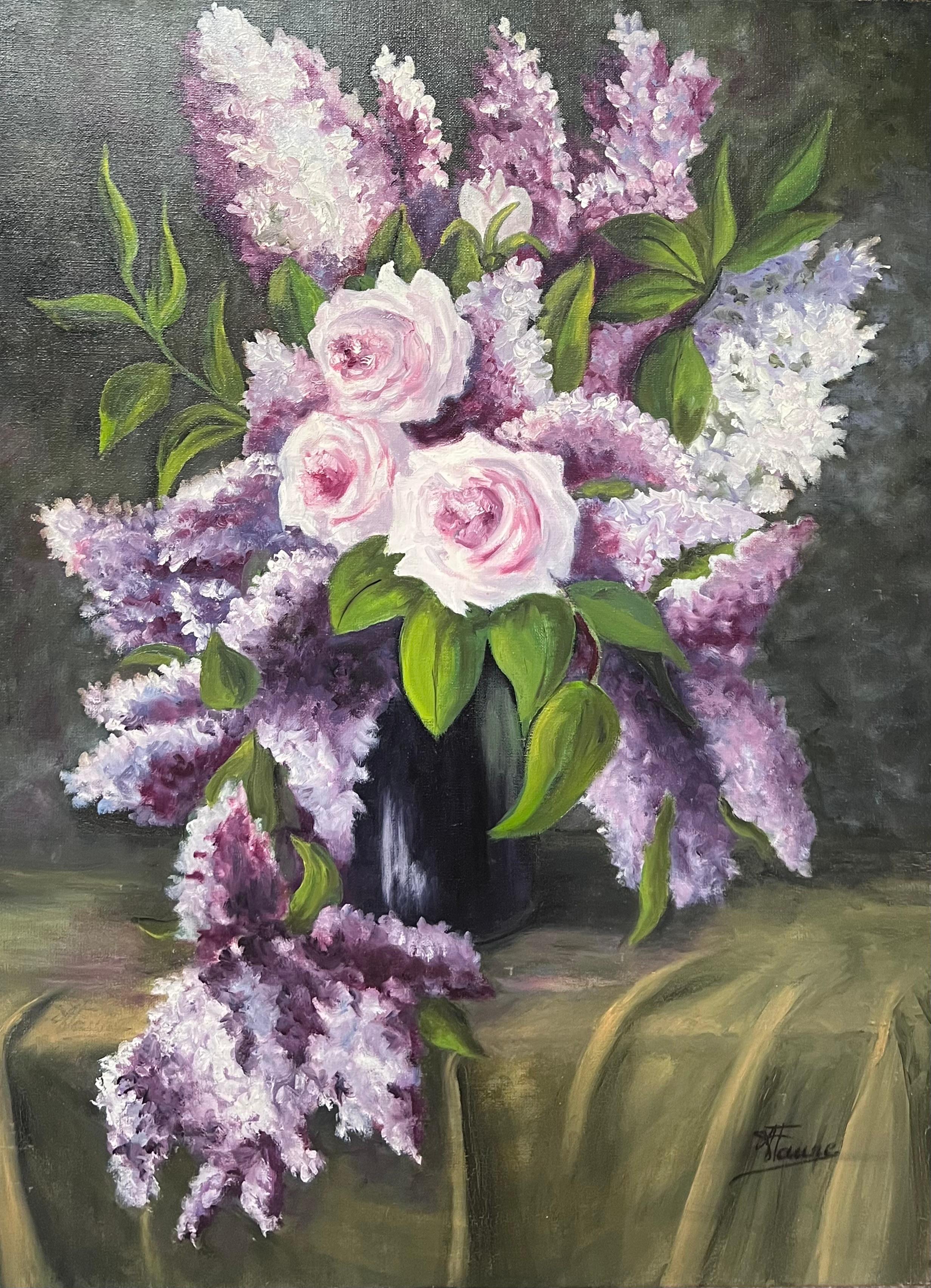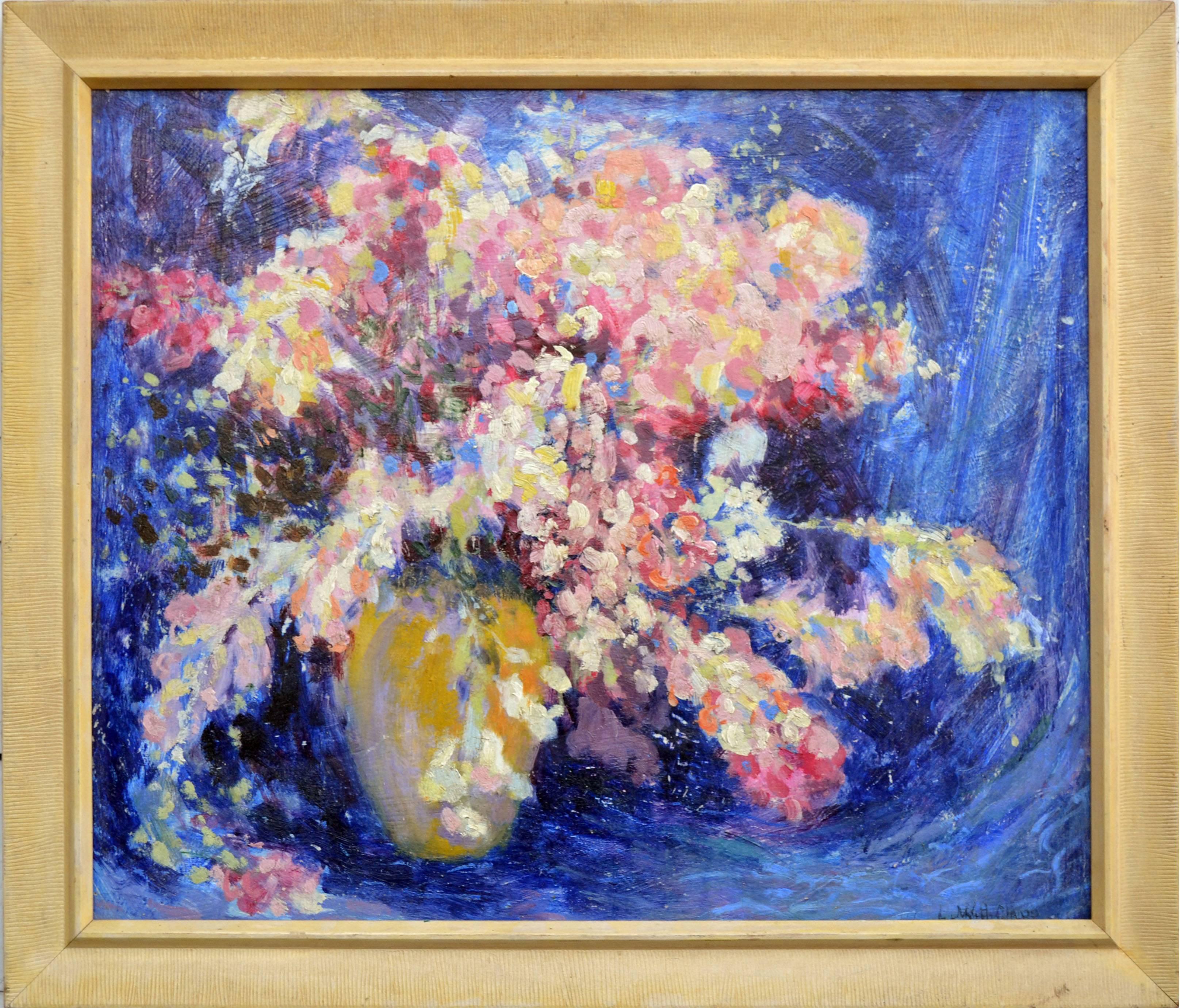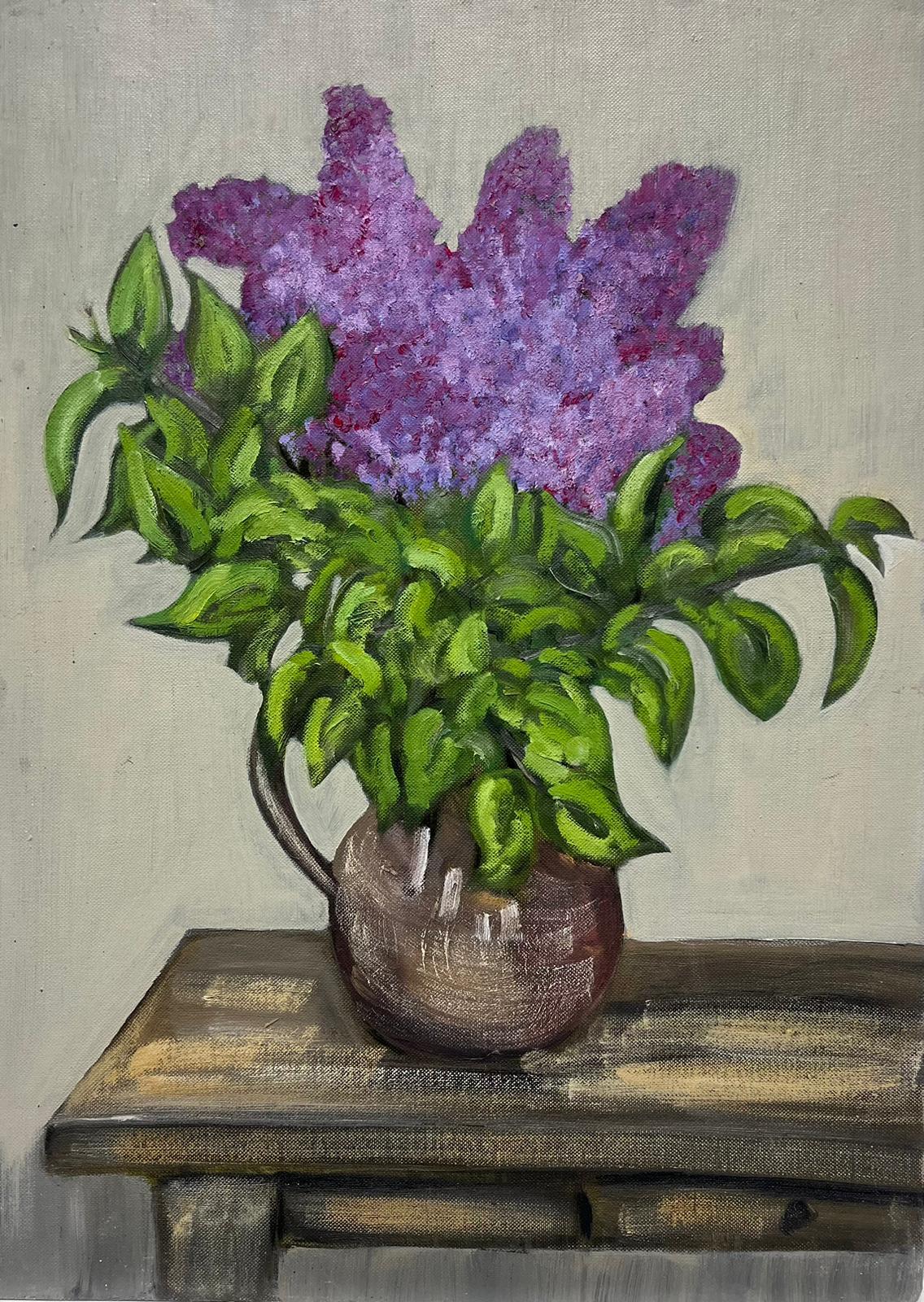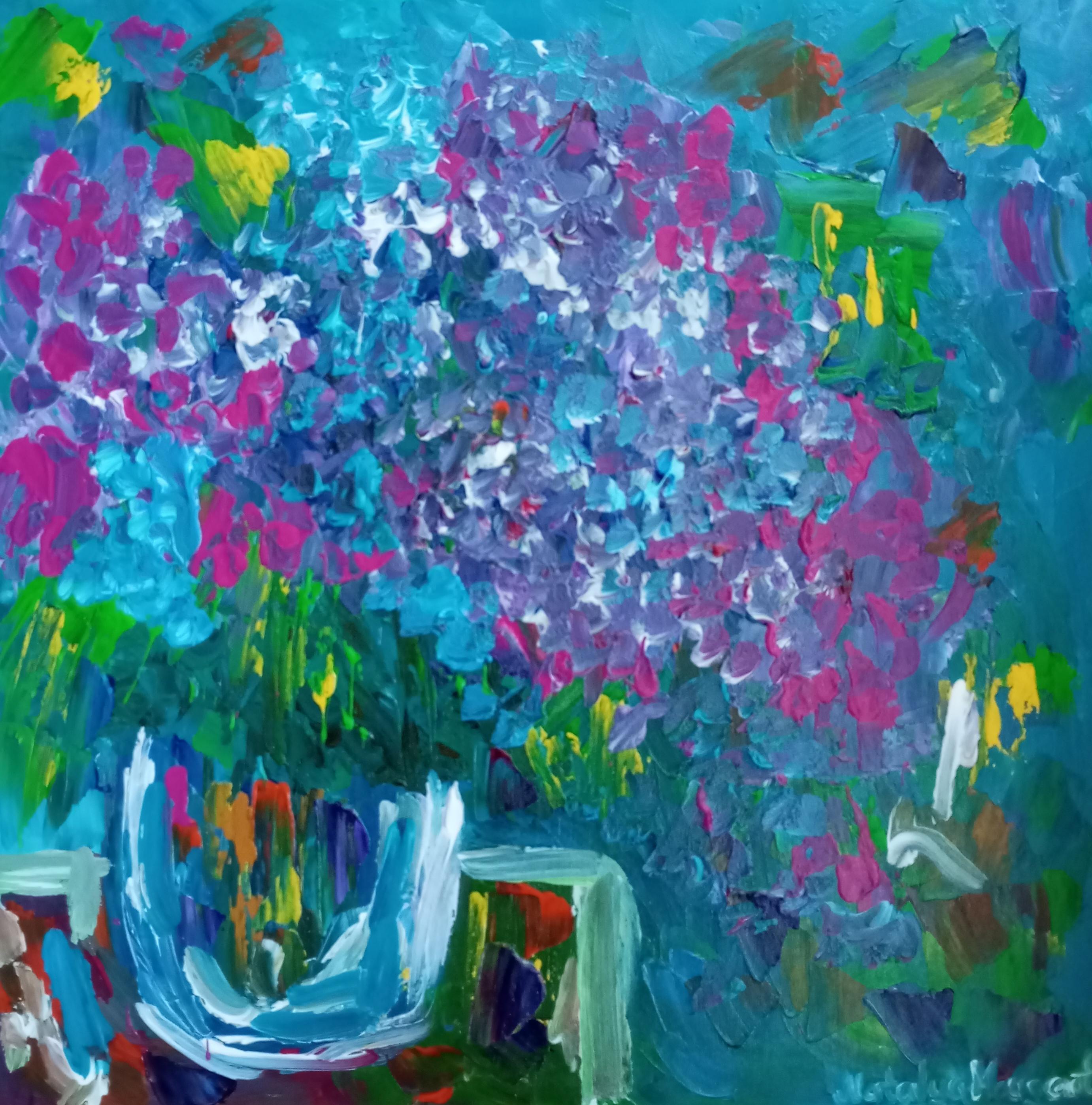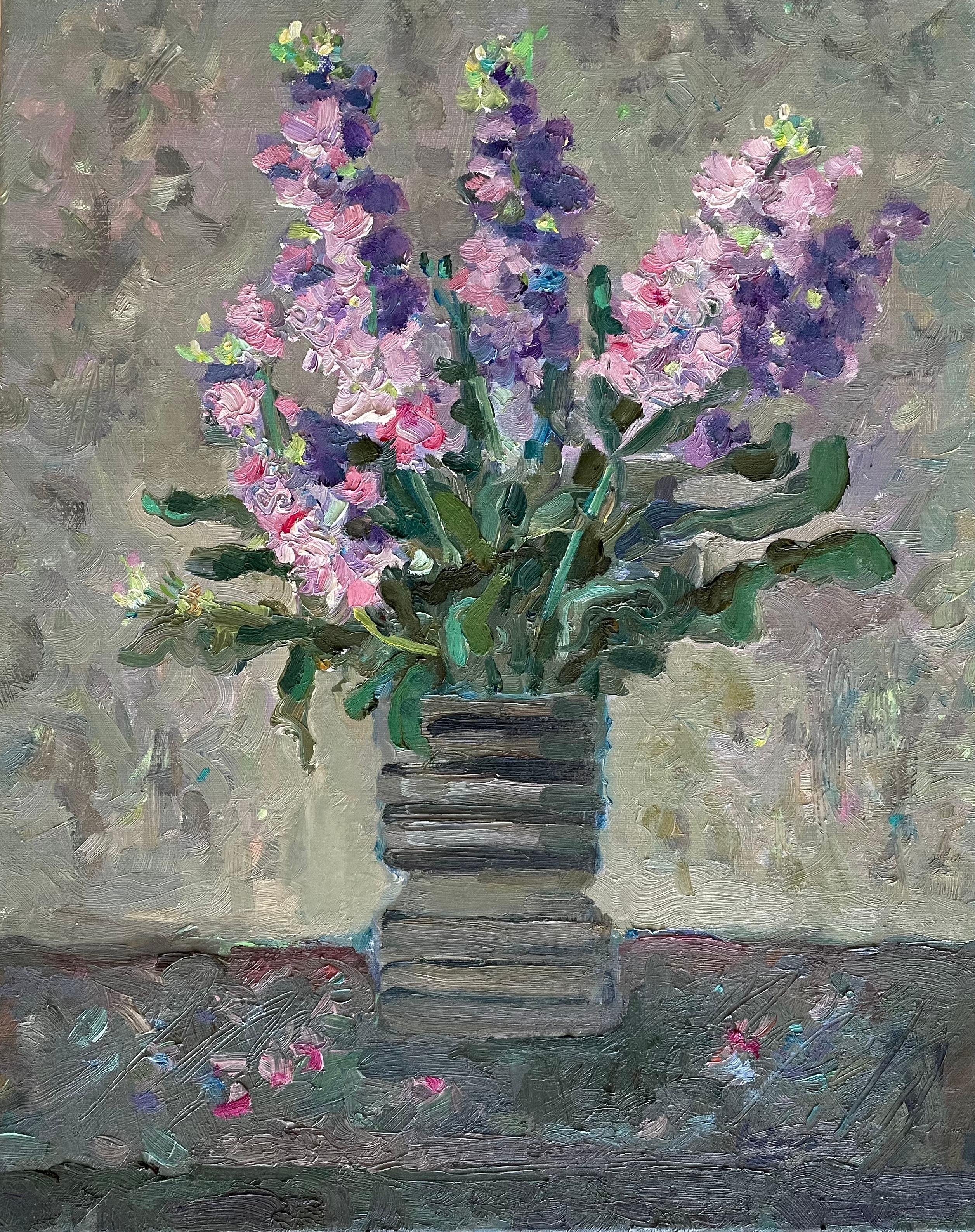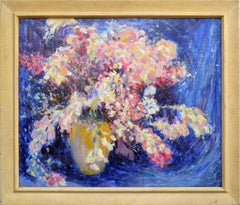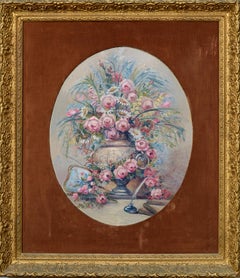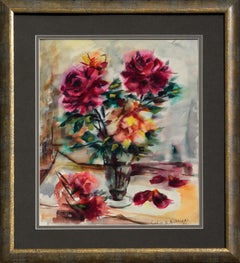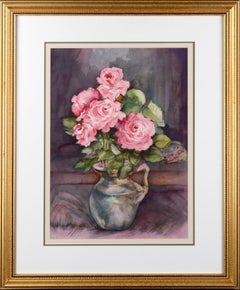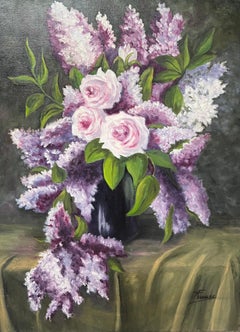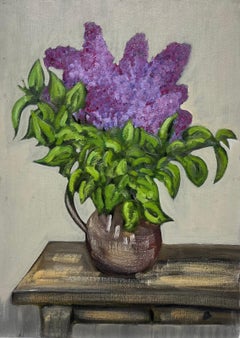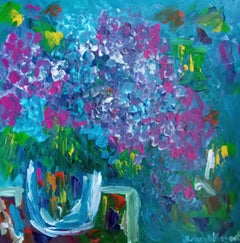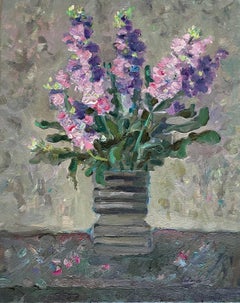Items Similar to Lilacs and Peonies, Mid Century Floral Still-Life with Pink & Purple
Want more images or videos?
Request additional images or videos from the seller
1 of 8
Carolyn TysonLilacs and Peonies, Mid Century Floral Still-Life with Pink & Purple1969
1969
$1,500
£1,146.83
€1,320.92
CA$2,101.96
A$2,346.64
CHF 1,229.60
MX$28,725.18
NOK 15,615.99
SEK 14,723.89
DKK 9,858.13
Shipping
Retrieving quote...The 1stDibs Promise:
Authenticity Guarantee,
Money-Back Guarantee,
24-Hour Cancellation
About the Item
Lilacs and Peonies, Mid Century Floral Still-Life with Pink & Purple
Vibrant mid century floral still-life featuring lilacs and peonies by Carolyn Tyson (American, b-1941). This lovely 1969 gouache piece uses a soft and feminine palette of light pinks and purples.
Signed and dated 1969 lower right.
Presented in a giltwood frame.
Image size: 24"H x 19"L.
- Creator:Carolyn Tyson (1941, American)
- Creation Year:1969
- Dimensions:Height: 34 in (86.36 cm)Width: 28 in (71.12 cm)Depth: 2 in (5.08 cm)
- Medium:
- Movement & Style:
- Period:
- Condition:
- Gallery Location:Soquel, CA
- Reference Number:Seller: JT-NS22301stDibs: LU542621902
About the Seller
5.0
Platinum Seller
Premium sellers with a 4.7+ rating and 24-hour response times
Established in 1986
1stDibs seller since 2014
2,960 sales on 1stDibs
Typical response time: <1 hour
- ShippingRetrieving quote...Shipping from: Soquel, CA
- Return Policy
Authenticity Guarantee
In the unlikely event there’s an issue with an item’s authenticity, contact us within 1 year for a full refund. DetailsMoney-Back Guarantee
If your item is not as described, is damaged in transit, or does not arrive, contact us within 7 days for a full refund. Details24-Hour Cancellation
You have a 24-hour grace period in which to reconsider your purchase, with no questions asked.Vetted Professional Sellers
Our world-class sellers must adhere to strict standards for service and quality, maintaining the integrity of our listings.Price-Match Guarantee
If you find that a seller listed the same item for a lower price elsewhere, we’ll match it.Trusted Global Delivery
Our best-in-class carrier network provides specialized shipping options worldwide, including custom delivery.More From This Seller
View All1920's Pink & Blue Impressionist Floral Still-Life Early Work Society of Six
By William Clapp
Located in Soquel, CA
A brilliant early 20th century impressionist floral still-life by William Clapp (American, 1879-1954). Beautiful and bold, this 1920's pink floral still-life pops against a bright blue background. The artist uses expressive and loose brushstrokes in a fun and energetic palette, bringing a dynamic and lively energy to this one-of-a-kind piece.
Signed lower right, "W. Clapp".
Oil on old Canada packing crate board and presented in a rustic wood frame.
Board size: 20"H x 24"L.
Framed size: 24"H x 28"W.
This an early work by the artist which is distinctive in his bold Impressionist style before he merged into his signature pointillist style.
Born in Montreal, Canada of American parents on Oct. 29, 1879. At age six Clapp moved to California with his family, settling in Oakland where he spent his childhood. In 1900 he returned to Montreal for four years of study with Wm Brymner followed by further study in Paris at Académies Julian, Colarossi, and Grande Chaumière. He then returned to Montreal where he was elected an associate member of the Royal Canadian Art Academy. He lived and worked in Cuba before returning to Oakland in 1917. He then served as director and curator of the Oakland Art Gallery from 1918-49. In this position, and as a member of a group of painters called the Society of Six...
Category
1920s American Impressionist Still-life Paintings
Materials
Board, Oil
Mid Century Pink Bouquet - Oval Floral Still-Life
Located in Soquel, CA
Mid-century oval floral still-life by M. Allen (American, 20th Century). Signed "M. Allen" lower right. Presented with a period oval shaped rust orange ve...
Category
Mid-20th Century American Impressionist Still-life Paintings
Materials
Oil, Board
$716 Sale Price
20% Off
Mid Century Pink Roses Floral Bouquet Still Life Watercolor
Located in Soquel, CA
Vibrant mid-century watercolor still-life of bright pink roses with petals falling on the table by Celia B. Michelena (American/Mexican, 1910-2006). Signed "Ce...
Category
Mid-20th Century Impressionist Still-life Drawings and Watercolors
Materials
Paper, Watercolor
Pink Roses, Spring Bouquet Still-Life
By Nancy Martin
Located in Soquel, CA
Vibrant and charming watercolor still-life of a bouquet of pink roses by Nancy Martin (English-American, 1906-2000). Signed "Nancy Martin" lower right. Di...
Category
Late 20th Century American Impressionist Still-life Drawings and Waterco...
Materials
Paper, Watercolor
$680 Sale Price
20% Off
Floral Still Life with Asters, Chrysanthemums and Peonies Original Mid Century
By Lillias Waddell
Located in Soquel, CA
Floral Still Life with Asters, Chrysanthemums and Peonies Original Mid Century
Vibrant mid century still life of a vase with asters, chrysanthemums, and peonies, as well as a small p...
Category
Early 20th Century American Impressionist Still-life Paintings
Materials
Linen, Oil, Stretcher Bars
Mid Century Pink & White Roses in Crystal Vase Still-Life
By Helen Enoch Gleiforst
Located in Soquel, CA
Delicate mid century still-life of white and pink roses in crystal vase with a soft, lime green background by listed California artist Helen Mae Enoch Gleiforst (American, 1903-1997)...
Category
1950s American Impressionist Still-life Paintings
Materials
Canvas, Oil
You May Also Like
Pink and Purple Bouquet of Lilacs and Roses 20th Century French Oil Painting
Located in Cirencester, Gloucestershire
Lilacs & Roses Still Life
by Annie Faure (French 1940-2021)
signed lower corner
oil painting on canvas, unframed
canvas size: 32 x 24 inches
condition: overall very good, minor surfa...
Category
Late 20th Century French School Still-life Paintings
Materials
Oil
Mid 20th Century French Oil Painting Purple Syringa Vulgaris Flowers Still Life
Located in Cirencester, Gloucestershire
by Louise Alix (French, 1888-1980) *see notes below
provenance stamp to the back
oil painting on board, unframed
measures: 18 high by 13 inches wide
condition: overall very good an...
Category
Mid-20th Century Impressionist Still-life Paintings
Materials
Oil
"Early blooming lilacs " (contemporary semi-abstract impressionist floral art)
Located in VÉNISSIEUX, FR
This contemporary semi-abstract impressionist floral composition features a vibrant bouquet of purple and blue lilacs in a vase.
In this abstract floral artwork I experience the wor...
Category
2010s Contemporary Still-life Paintings
Materials
Canvas, Acrylic
Mougenot Natalya"Early blooming lilacs " (contemporary semi-abstract impressionist floral art), 2024
$661 Sale Price
20% Off
Free Shipping
Stocks, flowers, pink, purple, vertical
Located in Oslo, NO
Original impressionist oil painting of stock flowers in a textured ceramic vase. The flowers are rendered with bold, expressive brushstrokes in shades of pink, lilac, and violet, acc...
Category
2010s Impressionist Still-life Paintings
Materials
Linen, Oil
Bouquet of flowers, tulips, lilacs and peonies
By Alexis Louis Roche
Located in Genève, GE
Work on canvas
Category
Mid-20th Century Modern Still-life Paintings
Materials
Oil
Still Life with Lilacs
By Nicolai Cikovsky
Located in Sheffield, MA
Nicolai Cikovsky
Russian, 1894-1984
Still Life with Lilacs
Oil on board
14 by 18 in, w/ frame 21 ⅝ by 25 ¾ in
Signed lower right
Landscape and figure painter Nicolai S. Cikovsky, 1...
Category
Mid-20th Century Impressionist Still-life Paintings
Materials
Oil
More Ways To Browse
Mid Century Pink Painting
Vintage Dance Photography
Picasso Print 1959
Etchings Portfolio
Vintage Vogue Magazine
Black And White Beach Photography
Relief Print
Marc Chagall Lithograph
Vintage Op Art
Los Angeles Black And White Photograph
Vintage Black And White Camera
Humphrey Bogart Photo
Roman Engravings
Arabic Art
Spain Wood Sculpture
Line Art Pencil
Vintage Animal Lithographs
Jean Michel Basquiat
